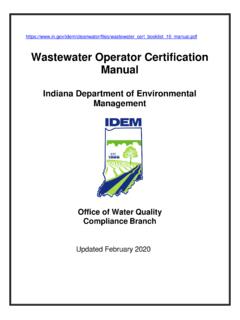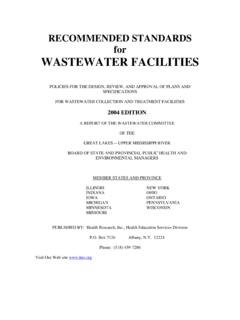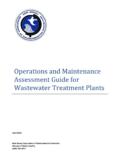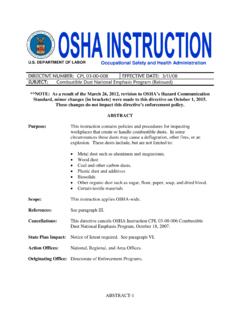Transcription of Guide for Evaluating Capacity, Management, Operation, and ...
1 Guide FOR Evaluating CAPACITY, MANAGEMENT, OPERATION, AND MAINTENANCE (CMOM) PROGRAMS AT SANITARY SEWER COLLECTION SYSTEMS United States Environmental Protection Agency Office of Enforcement and Compliance Assurance (2224A) EPA 305-B-05-002 January 2005 Guide for Evaluating CMOM Programs at wastewater Collection Systems TABLE OF CONTENTS 1. Introduction .. 1-1 Purpose of This Guide .. 1-1 1-1 How to Use the Guide .. 1-2 Overview of Underlying Issues.
2 1-3 Purpose of CMOM Programs .. 1-4 National Pollutant Discharge Elimination System Regulatory Requirement .. 1-5 EPA Region 4 MOM Programs Project .. 1-6 2. Collection System Capacity, Management, Operation, and Maintenance Programs .. 2-1 Collection System Management .. 2-4 Organizational Structure .. 2-4 Training .. 2-10 Internal Communication .. 2-11 Customer Management Information Systems .. 2-13 SSO Notification Program.
3 2-14 Legal Authority .. 2-15 Collection System Operation .. 2-17 Monitoring .. 2-19 Hydrogen Sulfide Monitoring and Control .. 2-20 Safety .. 2-21 Emergency Preparedness and Response .. 2-22 Modeling .. 2-24 Mapping .. 2-25 New Construction .. 2-26 Pump Stations .. 2-26 Equipment and Collection System Maintenance .. 2-27 Maintenance Budgeting .. 2-28 Planned and Unplanned Maintenance .. 2-28 Sewer Cleaning.
4 2-33 Parts and Equipment Inventory .. 2-35 Sewer System Capacity Evaluation - Testing and Inspection .. 2-36 Flow Monitoring .. 2-37 Sewer System Testing .. 2-38 Sewer System Inspection .. 2-39 Sewer System Rehabilitation .. 2-41 i Guide for Evaluating CMOM Programs at wastewater Collection Systems Checklist for Conducting Evaluations of wastewater Collection System Capacity, Management, Operation, and Maintenance (CMOM) Programs .. 3-1 Appendix A Example Collection System Performance Indicator Data Collection Form.
5 A-1 Appendix B Example Interview Schedule and Topics ..B-1 Appendix C Information Sources .. C-1 R-1 ii Guide for Evaluating CMOM Programs at Sanitary Sewer Collection Systems CHAPTER 1. INTRODUCTION Purpose of this Guide This Guide identifies some of the criteria used by EPA to evaluate a collection system s management, operation, and maintenance (CMOM) program activities. The Guide is intended for use by EPA and state inspectors as well as the regulated community owners or operators of sewer systems collecting domestic sewage as well as consultants or other third-party evaluators or compliance assistance providers.
6 Collection system owners or operators can review their own systems by following the checklist in Chapter 3 to reduce the occurrence of sewer overflows and improve or maintain compliance. The guidance herein may also be taken a step further. If a federal or state reviewer observes a practice that does not effectively meet the elements of a CMOM program, he or she may make recommendations to educate the operator, inspector, case developer, or those involved in a settlement agreement. Additionally, having key board members (policy makers) read this Guide will also allow them to better understand the benefits of investing in good CMOM programs.
7 The Guide is applicable to small, medium, and large systems; both publicly and privately owned systems; and both regional and satellite collection systems. Regardless of size, each owner or operator will have an organization and practices unique to its collection system. While these specific characteristics will vary among systems, the CMOM concepts and best management practices are likely to apply to all types of systems. Where appropriate, this document provides guidance on the differences. This document does not, however, substitute for the CWA or EPA s regulations, nor is it a regulation itself.
8 Thus, the document does not and cannot impose legally binding requirements upon these circumstances. EPA and state decision-makers retain the discretion to adopt approaches on a case-by-case basis that differ from this guidance where appropriate. EPA may change this guidance in the future. Individuals reviewing a collection system are strongly encouraged to read the guidance portion of this document prior to conducting a review. Reviewers should use the checklist in Chapter 3 as the primary tool for questions during the paperwork and/or onsite review of the collection system.
9 While some sections or topics may not appear to relate directly to environmental performance, taken as a whole, they provide an indication of how well the utility is run. Terminology To provide a more user-friendly guidance and for clarification, the terminology for several terms has been modified. The following paragraphs list these terms and reasoning for the modifications. Frequently, the term COLLECTION SYSTEM OWNER OR OPERATOR , abbreviated as OWNER OR OPERATOR, is used in this Guide and refers to the entities responsible for the administration and oversight of the sewer system and its associated staff (in either a municipal or industrial context); capacity evaluation, management, operation, and maintenance programs; equipment; and facilities.
10 The owner and operator may be two different entities. For example, the owner may own the infrastructure and be responsible for its maintenance while it designates responsibility for the day to day operation of 1-1 Guide for Evaluating CMOM Programs at Sanitary Sewer Collection Systems the system to the operator. It should be noted that the term used in EPA s CMOM Program Self Assessment Checklist is MUNICIPAL wastewater UTILITY OPERATORS or UTILITY rather than collection system owner or operator.

















